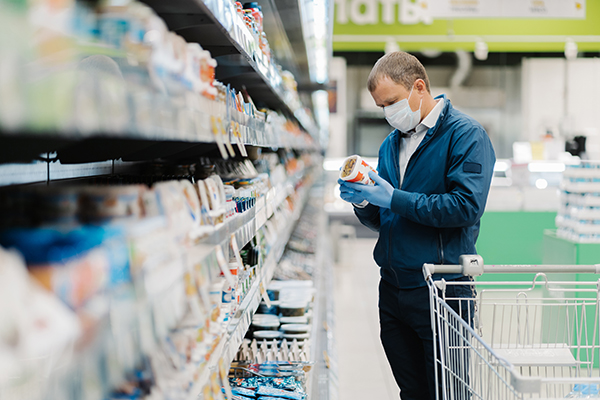Dispelling Myths about Food Safety
Welcome to September and National Food Safety Education month – the favorite month of the year for all of us food safety nerds. While we all should be practicing safe food handling during each month and day of the year, National Food Safety month provides us an annual reminder to follow the simple steps to ensure the food we serve in our operations is safe and provides us a reason to raise awareness of food safety.
In doing food safety education and training, often we find that people are aware of food safety and the importance of it, at least they say they do. But we often find there are a great deal of myths about food safety. What better time of the year to try and dispel some of those myths about food safety than during food safety education month.
If we could reduce the burden of foodborne disease by just 1%, 48,000 people will be kept from getting sick, saving potentially 30 lives – EACH YEAR! Below are some of the myths that we often hear in the food safety world, and perhaps you’ve heard some of these yourselves. I’ve included a potential response to provide the next time you hear each of these myths uttered by an employee, colleague, or friend.
We all hear food safety myths every day. Below are a few of the common ones, along with why it is a myth. So, next time you hear an employee, friend, or colleague state one of these myths, set the record straight.
Myth: If it looks and smells fine, it’s safe!
Fact: I get it – we don’t want to be wasteful and the mantra of reducing waste and having a sustainable mindset has never been more prevalent than it is today. But ask anyone who has ever had a foodborne illness, and most will tell you the food looked, smelled, and tasted fine. From May into August of 2021, we had an ongoing outbreak of Salmonella tied back to Fratelli Beretta brand prepackaged uncured antipasto trays. Most of those consumers never suspected a problem until weeks after consuming the product and falling ill. Pathogenic bacteria that can cause illness does not always cause the same change in food that spoilage bacteria, yeasts, and molds do. While you obviously wouldn’t eat something that does smell or look bad, these important indicators are not the only indicators of a food that can make you ill.
Myth: You should always rinse raw chicken before cooking it.
Fact: I am not sure who first told food handlers to wash their chicken before cooking it. I still had employees who believed this to be the gospel truth, too. In some places, I have heard Julia Child blamed, but I can’t believe she would do such a thing! But stop! Just stop! You are essentially splashing bacteria all over your sink and food prep area. One study found that you could be splashing those bacteria as far as 27 ½ inches from where you are washing[1]. Besides, what good is washing off the chicken? If you think you can wash away the pathogens, wouldn’t we just wash all food before eating it and solve all our food safety problems? What is it exactly that we think we are washing away, anyway?
Myth: The five second rule.
Fact: I’d like to think that deep, deep down, humanity always knew this was not correct – that those who are fast at picking food up on the floor can help prevent foodborne contamination. This reminds me of something a 4-year-old, who is decked out in a cape and superhero’s costume might exclaim as they tout their superhuman speed as opposed to your speed of a mere mortal. There are certainly several factors that play a part in the transfer of pathogenic bacteria to food, including the type of food, the surface, and yes, even the time of contact. The truth is the transfer of some bacteria to food happens almost instantaneously, leaving the five second rule busted once and for all [2],[3]
Myth: The last meal I ate caused me to get sick.
Fact: Don’t be so quick to judge the last meal or foodservice operation if you fall ill from food. Most microorganisms that cause foodborne illness take a minimum of a few hours to weeks to cause you to become ill. For example, E. Coli symptoms may not appear until three to four days after exposure. Listeria can take one to four weeks from the time you are exposed until you start to see symptoms. Conversely, others like Staphylococcus aureus can appear in as little as 30 minutes to eight hours after exposure. For more information, check out the Food Poisoning Symptoms page at the Centers for Disease Control and Prevention.
Myth: If you let the food sit out to thaw, you kill all the bacteria when you cook it.
Fact: Yes, cooking will destroy foodborne bacteria. But, some bacteria, such as Staphylococcus aureus, produces a toxin as it is multiplying. In the case of Staphylococcus aureus, it reproduces at temperatures from about 50°F to 120°F, with the most rapid growth occurring around body temperatures. When you cook a product contaminated with Staphylococcus aureus, you kill the bacteria, but the toxin, which is extremely heat stable, remains. That toxin is what will make you ill and is one of the reasons the onset of Staphylococcus aureus can occur so quickly (see the previous question for more details). Other examples of bacteria that may survive cooking include Clostridium perfringens, Enteropathogenic E. coli, and Clostridium botulinum.
Myth: After thawing a food, you cannot refreeze it. It must be either used or thrown away.
Fact: While this may be a quality concern, it is NOT a safety concern. The danger of freezing food, thawing it, and then cooking is not the freezing part, it is the thawing. If the food is thawed properly, there is no reason a food cannot be refrozen once thawed.
Myth: This food is local, organic, or natural, so it’s safe.
Fact: We will often hear comments about how local or organic food is safer. However, there is no reason to believe, nor do any studies show organic foods have lower incidents of foodborne illness than their counterparts[4],[5]. While local foods can sometimes be delivered to your home or food service operation in a fraction of the time it might take to get from a commercial source, it does not mean it is safer. One of our previous blogs discussed ways to mitigate risk related to fresh produce.
These are just a small fraction of the myths that we in the food safety hear each year. Did I miss one that you always hear? If so, send it to me via email! If I hear a few, I will discuss in a blog in the future.
In honor of food safety education month, we have planned a special SafeBites Webinar this month. The purpose of food safety education is to change employee behavior and improve practices, something we have all struggled with – whether it be for ourselves personally or our employees. So, the title of this month’s webinar is Using Stories to Change Behaviors of Foodservice Employees and will explore a novel approach to changing behavior. Our presenter will be Dr. Kevin Sauer, professor of Food, Nutrition, Dietetics, and Health at Kansas State University and president of the Academy of Nutrition and Dietetics. Join us to discuss this very timely topic on September 15 at 1:00 pm. Registration is free, so register today! Risk Nothing.
[1] Everis, L., & Betts, G. D. (2003). Microbiological risk factors associated with the domestic handling of meat: Sequential transfer of bacterial contamination. Campden & Chorleywood Food Research Association Group.
[2] Miranda, R. C., & Schaffner, D. W. (2016). Longer contact times increase cross-contamination of Enterobacter aerogenes from surfaces to food. Applied and environmental microbiology, 82(21), 6490-6496.
[3] Lueangprasert, K., & Saelim, K. Transfer of Escherichia coli TISTR527 from Surface to Fresh-Cut Cantaloupe.
[4] Mukherjee, A., Speh, D., Jones, A. T., Buesing, K. M., & Diez-Gonzalez, F. (2006). Longitudinal microbiological survey of fresh produce grown by farmers in the upper Midwest. Journal of food protection, 69(8), 1928-1936.
[5] Reinstein, S., Fox, J. T., Shi, X., Alam, M. J., Renter, D. G., & Nagaraja, T. G. (2009). Prevalence of Escherichia coli O157: H7 in organically and naturally raised beef cattle. Applied and environmental microbiology, 75(16), 5421-5423.










